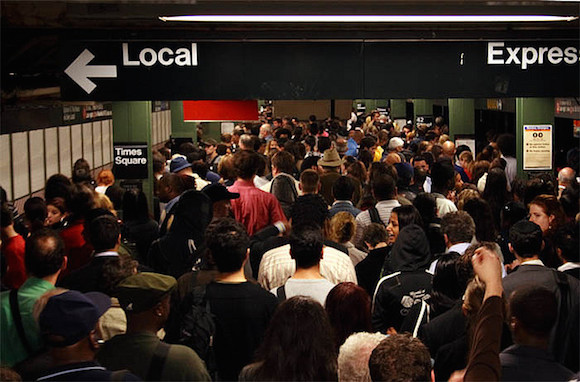
Guess we didn’t need to invent reasons to dread our morning commute, after all—according to the New York Post, we’re doing just fine making it a living hell on our own. Their recent statistics report a (literally) crushing 113% increase in weekday train delays due to overcrowding last December, mostly due to assholes lack of rider etiquette and that person holding the doors open trying to be the last one to squeeze on the train.
The Post also reports a 146% spike compared to 2013 in weekend delays due to overcrowding, and a month’s worth of days where ridership hit the 6-million mark. But hey, that’s over half the city’s population. Not much of a shocker, when you consider how wide-reaching public transportation in the city and its boroughs really is.
The seeming solution to overcrowding would be to have more trains, but that would also just mean more trains stopping mid-tunnel because they were “delayed by train traffic ahead,” right? Another option would be for the entirety of Midtown Manhattan to stagger corporate work schedules, so some people didn’t have to cram into trains until 10am or later.
You know what? Better solution than either of the above. Let’s just have one long limousine train on each line that stretches from one end to the other, never moving, and we can just walk the whole damn way to our destinations past subway preachers, nutcracker salesmen and “showtime” obstacles. It’ll be just like Indiana Jones, but with more fun smells.
One Response to
Leave a Reply




Let’s talk about that dreaded “train traffic” then – the MTA uses outdated, static train spacing systems that haven’t been updated since the 1930s. This technology is unreliable, breaks often, and parts need to be special ordered.
Most other metropolitan areas use Communications Based Train Control (CBTC) to space trains dynamically. What does this mean? You can run more trains per hour. The technology is wireless and removable in case of possible flooding (Sandy). The L train and the 7 train run CBTC. Although there are unique issues that CBTC present for our system, it should be top priority for the MTA, not countdown clocks or fancy interactive maps in the subway.
Maybe if people start lobbying for CBTC instead of complaining about overcrowding on trains we can fix this.